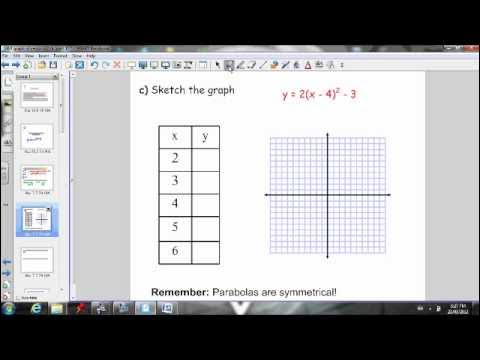TRANSFORMING QUADRATIC FUNCTIONS FROM GENERAL FORM TO STANDARD/VERTEX FORM AND VICE VERSA
Summary
TLDRThis video tutorial explains how to transform a quadratic function from its general form, y = ax^2 + bx + c, to its vertex or standard form, y = a(x-h)^2 + k, and vice versa. The speaker covers completing the square to form perfect square trinomials and converting equations step-by-step. Additionally, there are examples with solutions to solidify understanding, including how to expand functions back to general form. The tutorial ends with a short quiz to review key concepts. Ideal for students learning quadratic functions, it combines explanation, examples, and practice.
Takeaways
- 🧮 The general form of a quadratic function is y = ax² + bx + c, and the vertex (or standard) form is y = a(x - h)² + k.
- 🔄 To transform from general form to vertex form, group terms, complete the square, and adjust constants accordingly.
- ✍️ Completing the square involves adding (b/2)² and subtracting it to form a perfect square trinomial.
- 📐 Express the perfect square trinomial as the square of a binomial, which helps rewrite the equation in vertex form.
- ✔️ The values of a, h, and k in the vertex form represent the quadratic's shape and position on the graph, with h and k marking the vertex.
- 🔢 A perfect square trinomial example: x² - 8x + 16 can be factored as (x - 4)².
- 📝 In another example, x² + 3x + 9/4 is expressed as (x + 3/2)² after completing the square.
- 🔍 Factoring out the coefficient of x² is necessary when a ≠ 1 before completing the square, such as in the example y = 2x² + 6x - 5.
- 🧑🏫 Expanding vertex form back into general form requires applying the distributive property and combining like terms.
- ✅ Several examples are given to reinforce understanding of converting between general and vertex forms of quadratic functions, with step-by-step calculations.
Q & A
What is the general form of a quadratic function?
-The general form of a quadratic function is y = ax^2 + bx + c.
What is the vertex form (standard form) of a quadratic function?
-The vertex form (or standard form) of a quadratic function is y = a(x - h)^2 + k, where (h, k) is the vertex of the parabola.
What is the first step in transforming a quadratic function from general form to vertex form?
-The first step is to group the terms that contain x and factor out 'a' from those terms if a ≠ 1.
How do you complete the square when transforming a quadratic function to vertex form?
-To complete the square, add (b/2)^2 to both sides of the equation inside the parentheses and subtract a(b/2)^2 from the constant term.
What is the purpose of completing the square in the context of transforming a quadratic function?
-Completing the square allows us to express the quadratic function as a perfect square trinomial, which can be factored into the form (x - h)^2.
How can you find the values of 'h' and 'k' when converting to vertex form?
-The value of 'h' is found by dividing the coefficient of x (b) by 2, and squaring it to get the perfect square. The value of 'k' is derived by simplifying the equation after completing the square.
How do you go from vertex form back to general form?
-To revert from vertex form to general form, expand the binomial (x - h)^2, distribute the 'a' term, and combine like terms with any constant.
In the example y = x^2 - 6x + 14, what are the values of a, h, and k in vertex form?
-For the equation y = x^2 - 6x + 14, the values are a = 1, h = 3, and k = 5 in vertex form.
What is the method to factor a perfect square trinomial into a binomial square?
-To factor a perfect square trinomial, express it as (x - b/2)^2, where b is the coefficient of x in the original trinomial.
What are the steps to transform y = 2x^2 + 6x - 5 into vertex form?
-First, factor out the 'a' value from the terms containing x (if a ≠ 1), complete the square by adding and subtracting (b/2)^2 inside the equation, then simplify the constant term to get the final vertex form.
Outlines

Dieser Bereich ist nur für Premium-Benutzer verfügbar. Bitte führen Sie ein Upgrade durch, um auf diesen Abschnitt zuzugreifen.
Upgrade durchführenMindmap

Dieser Bereich ist nur für Premium-Benutzer verfügbar. Bitte führen Sie ein Upgrade durch, um auf diesen Abschnitt zuzugreifen.
Upgrade durchführenKeywords

Dieser Bereich ist nur für Premium-Benutzer verfügbar. Bitte führen Sie ein Upgrade durch, um auf diesen Abschnitt zuzugreifen.
Upgrade durchführenHighlights

Dieser Bereich ist nur für Premium-Benutzer verfügbar. Bitte führen Sie ein Upgrade durch, um auf diesen Abschnitt zuzugreifen.
Upgrade durchführenTranscripts

Dieser Bereich ist nur für Premium-Benutzer verfügbar. Bitte führen Sie ein Upgrade durch, um auf diesen Abschnitt zuzugreifen.
Upgrade durchführenWeitere ähnliche Videos ansehen

Matematika Kelas 9 : Fungsi Kuadrat (Part 1 : Bentuk umum dan grafik fungsi kuadrat)

Menyusun fungsi kuadrat (part 1)

Writing a Quadratic Function from Points (Example)

ILLUSTRATING QUADRATIC EQUATIONS || GRADE 9 MATHEMATICS Q1

4.4 Day 1 - Graphing Parabolas in Vertex Form (Part 1)

Intro to Quadratic Functions (Relations) - Nerdstudy
5.0 / 5 (0 votes)
